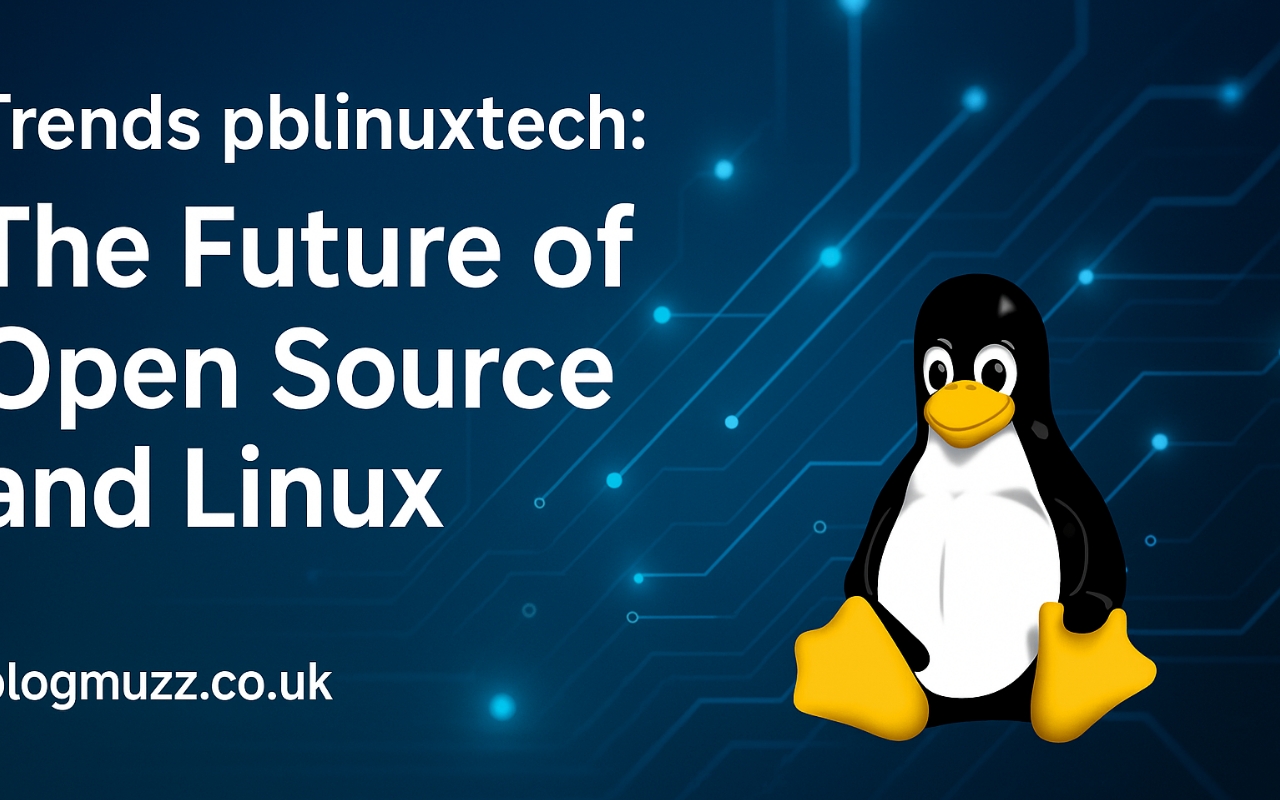Introduction: Understanding the Scope of Trends pblinuxtech
When we talk about trends pblinuxtech, we are essentially discussing the ongoing transformation of the open-source and Linux ecosystems. Over the past few decades, Linux has grown from being a project for hobbyists into one of the most reliable and widely used platforms in the world. Today, it powers everything from personal computers to supercomputers, smartphones, IoT devices, and massive cloud infrastructure. In the same way, open-source software has evolved into a central pillar of modern digital innovation. This article explores the trends pblinuxtech community is shaping, the opportunities it creates, and the future it promises for developers, enterprises, and users alike. With the expansion of cloud computing, AI, edge computing, and cybersecurity, open-source and Linux are no longer niche—they are mainstream. In this piece, we will dive into the most important aspects of these trends, structured under multiple headings to give you a comprehensive picture.
The Evolution of Open Source in the Context of Trends pblinuxtech
Open-source software began as a grassroots movement but has now become the backbone of technological innovation. Trends pblinuxtech demonstrate how companies and communities have realized the power of collaboration. Unlike proprietary software, open source empowers developers worldwide to contribute, refine, and share. This collaborative model not only accelerates development but also ensures transparency, security, and innovation. For instance, projects like Kubernetes, TensorFlow, and the Linux kernel itself are shining examples of how distributed efforts result in global adoption. The trends pblinuxtech focus on the fact that corporations like IBM, Google, and Microsoft are heavily investing in open-source development, making it clear that the old idea of “open source vs. enterprise” no longer applies. Instead, enterprises have recognized that open-source models are crucial for long-term scalability and innovation.
Linux as the Foundation of Future Technologies
Linux has consistently been at the forefront of trends pblinuxtech, largely due to its flexibility, security, and adaptability. It is no exaggeration to say that Linux has become the operating system of choice for the future. From powering Android smartphones to serving as the foundation of cloud infrastructures like AWS, Azure, and Google Cloud, Linux is deeply integrated into modern computing. One of the significant trends pblinuxtech highlights is the growing use of Linux in containerization and orchestration technologies such as Docker and Kubernetes. Developers are embracing Linux not just for its stability but also because it offers the freedom to customize and scale operations. Furthermore, with the rise of IoT devices, Linux’s lightweight distributions are making it easier to deploy scalable, low-resource systems globally. As technology moves toward decentralization and edge computing, Linux remains an indispensable component.
Cloud Computing and Trends pblinuxtech
Cloud computing is inseparable from the discussion of trends pblinuxtech. The entire architecture of modern cloud systems owes its existence to open-source technologies. Without Linux and open-source platforms, cloud services would not have reached their current maturity. Major cloud providers build their infrastructures primarily on Linux systems. Kubernetes, an open-source container orchestration platform, has become the de facto standard for managing cloud-native applications. Trends pblinuxtech also point to the rise of hybrid and multi-cloud environments, where organizations prefer to keep workloads flexible across different cloud vendors. Open source plays a vital role here, as it ensures interoperability, reduces vendor lock-in, and gives enterprises more control. As businesses continue to migrate to cloud-native architectures, trends pblinuxtech reinforce the significance of open-source software as the enabler of this transition.
Artificial Intelligence and Machine Learning in Trends pblinuxtech
One of the most exciting developments within trends pblinuxtech is the intersection of open-source with artificial intelligence (AI) and machine learning (ML). Open-source frameworks like TensorFlow, PyTorch, and Apache MXNet have democratized access to AI tools. Instead of being restricted to large corporations, these technologies are available to individual developers, startups, and research institutions. Trends pblinuxtech indicate that AI development thrives in an open-source ecosystem because collaboration accelerates innovation. Additionally, the Linux platform provides the necessary infrastructure for running AI workloads efficiently, whether on local servers, cloud environments, or edge devices. The trend of combining AI with open-source software is reshaping industries such as healthcare, finance, autonomous vehicles, and cybersecurity. As we move forward, the trends pblinuxtech community will continue to play a pivotal role in ensuring AI remains transparent, ethical, and accessible.
Cybersecurity and the Importance of Open-Source Solutions
Cybersecurity has become a dominant concern in the digital age, and trends pblinuxtech shed light on how open-source solutions address these challenges. With cyberattacks growing more sophisticated, transparency is critical in detecting vulnerabilities and ensuring security. Unlike proprietary software, open-source code is open for review, making it easier to identify and fix potential threats. Popular security tools such as Snort, Suricata, and OpenVAS exemplify the power of open-source in defending against cyberattacks. Trends pblinuxtech highlight how enterprises increasingly rely on Linux-based servers because of their reputation for security. Additionally, the community-driven approach ensures that when vulnerabilities arise, patches are developed and distributed swiftly. In a time when digital trust is paramount, trends pblinuxtech emphasize the growing role of open-source cybersecurity measures in protecting both individuals and organizations.
Trends pblinuxtech in the Era of Edge Computing and IoT
The rapid rise of edge computing and IoT devices represents another frontier where trends pblinuxtech dominate. Linux distributions like Ubuntu Core, Fedora IoT, and Yocto Project are optimized to support IoT deployments. Edge computing requires lightweight, efficient, and scalable systems, which Linux and open-source technologies are well-equipped to deliver. Trends pblinuxtech illustrate how businesses are increasingly deploying Linux-powered IoT devices to process data locally, reducing latency and enhancing performance. For instance, in industries such as manufacturing, healthcare, and transportation, IoT systems built on Linux enable real-time analytics and decision-making. Open-source tools also make IoT ecosystems more secure by allowing peer reviews and rapid improvements. With billions of devices expected to connect in the coming years, Linux and open-source technologies will remain central to the expansion of edge computing.
The Role of Community in Shaping Trends pblinuxtech
One of the most defining features of trends pblinuxtech is the role of community. Unlike proprietary software, where decisions are made behind closed doors, open-source thrives on contributions from developers, testers, and enthusiasts across the globe. Communities around Linux distributions, such as Debian, Fedora, and Arch, demonstrate how collective effort can sustain projects for decades. The same applies to broader open-source communities supporting projects like Apache, Mozilla, and Git. Trends pblinuxtech underscore how community governance leads to software that is more adaptable, transparent, and aligned with user needs. Furthermore, the rise of platforms like GitHub and GitLab has made it easier than ever for contributors to collaborate, share, and innovate. The future of trends pblinuxtech will continue to be shaped by the strength and inclusiveness of these communities.
Enterprise Adoption and Trends pblinuxtech
Another significant aspect of trends pblinuxtech is the widespread adoption of open-source and Linux by enterprises. Companies like Red Hat, Canonical, and SUSE have successfully built business models around supporting open-source technologies. Trends pblinuxtech highlight how organizations are increasingly shifting to open-source solutions to reduce costs, avoid vendor lock-in, and gain more control over their IT infrastructure. Even industries that were once skeptical of open source—such as finance and government—are now embracing it. Enterprise adoption is not just limited to Linux servers; it also extends to container technologies, DevOps practices, and security solutions. As more enterprises integrate open-source into their core strategies, trends pblinuxtech reveal a future where open-source and Linux are not optional but essential.
Future Predictions: Where Trends pblinuxtech Are Headed
Looking forward, trends pblinuxtech point toward even greater integration of open-source technologies in every aspect of digital life. With the expansion of quantum computing, blockchain, and advanced AI, open-source will continue to serve as the foundation for experimentation and innovation. Linux will remain the operating system of choice for developers building cutting-edge applications. In the long run, trends pblinuxtech predict a world where open-source collaboration transcends geographical boundaries and becomes the default approach to solving global challenges. From smart cities to sustainable energy solutions, open-source and Linux will play a defining role in shaping the digital future. Enterprises, governments, and individuals alike will rely more on transparent, community-driven technologies to ensure both innovation and trust.
Conclusion: The Lasting Impact of Trends pblinuxtech
In conclusion, trends pblinuxtech capture the transformative journey of open-source and Linux from niche projects to global powerhouses. They highlight the critical role of collaboration, transparency, and adaptability in driving technological progress. Whether in cloud computing, AI, cybersecurity, or IoT, the influence of open-source software is undeniable. Linux continues to evolve as the backbone of modern digital infrastructure, while open-source communities ensure its sustainability and innovation. As we look ahead, trends pblinuxtech reinforce the idea that the future of technology will not be dictated by closed, proprietary systems but by open, collaborative ecosystems. For developers, enterprises, and everyday users, this means more opportunities, greater flexibility, and a more inclusive digital world. The future of open-source and Linux is bright, and trends pblinuxtech are the roadmap guiding us there.



